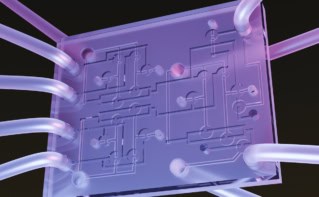Yesterday I went to a news conference given by five physicists who believe that materials called “block copolymers” could help the electronics industry continue its relentless drive towards smaller and smaller devices — and even help battle some cancers.
Block copolymers are a hot topic in nanotechnology because of their ability to self-organize into tiny structures.
They are essentially two different kinds of polymer that are joined end-to-end to create one long strand. The two polymers normally repel each other — creating something akin to “cats and dogs with their tails tied together”.
Similar polymer ends are attracted to each other and the competing forces tends to organize the copolymers into one of several possible solid structures, depending on external parameters such as temperature.
These strucutures have features on length scales of tens of nanometres, which is just about the right size for future generations of electronic devices.
One possibility, according to Chris Ober of Cornell University is that block copolymers could be used to create patterns on the surface of a silicon wafer with features much smaller than is possible using standard lithography techniques. An etching process — with the block copolymer acting as the etch resist — could then be used to create nanometre-scale electronic devices. Indeed, Ober believes that computer chips could be made this way in the next five years.
Other electronice applications include high-density magnetic memory chips and “low-K” insulators, which which would allow tiny circuits to run faster.
Dan Savin of the University of Vermont believes that block copolymers could be used to create tiny capsules that would deliver drugs to specific parts of the body. For example, a capsule that was the right shape and size to get from the bloodstream and into a tumour.
However, one serious drawback of self assembly at the moment is that there are a limited number of structures that the block copolymers can form. But I’m guessing that this could be expanded by using more than just two ends — maybe cats and dogs and mice with their tails tied together!



